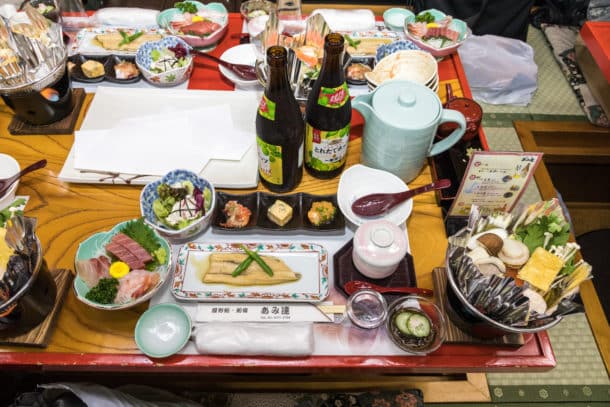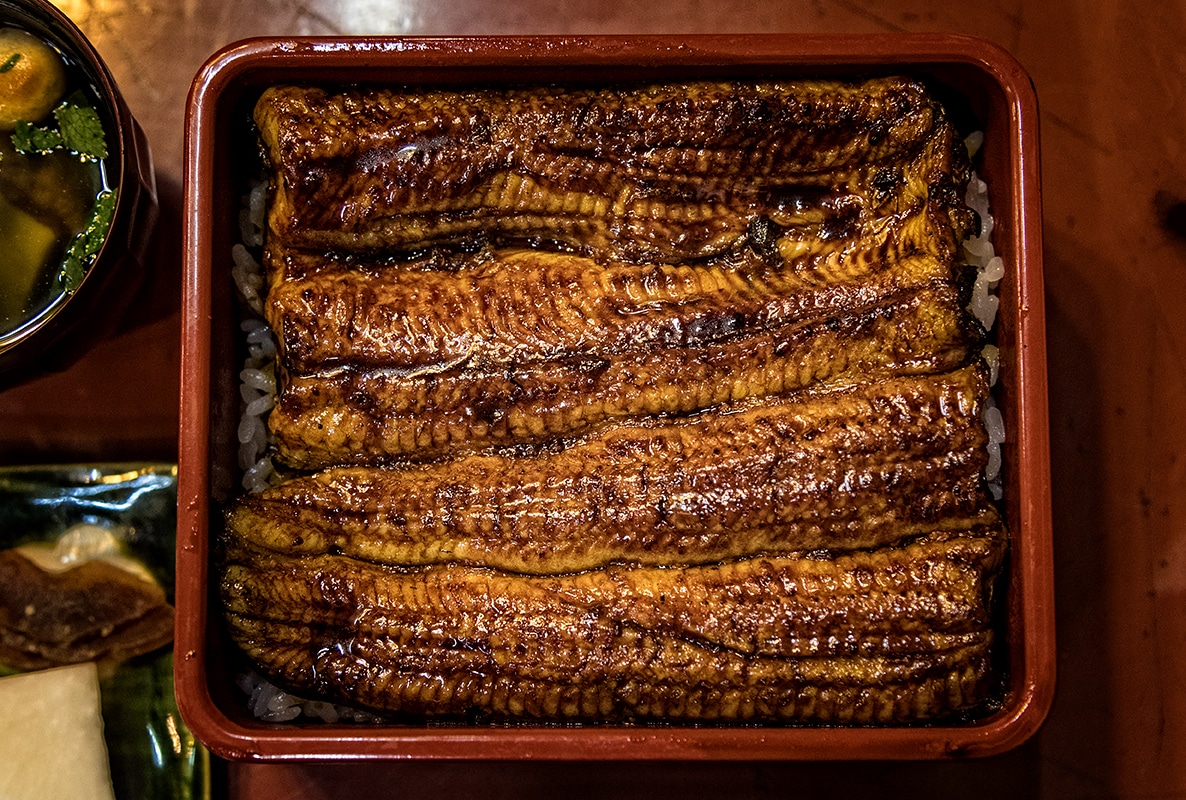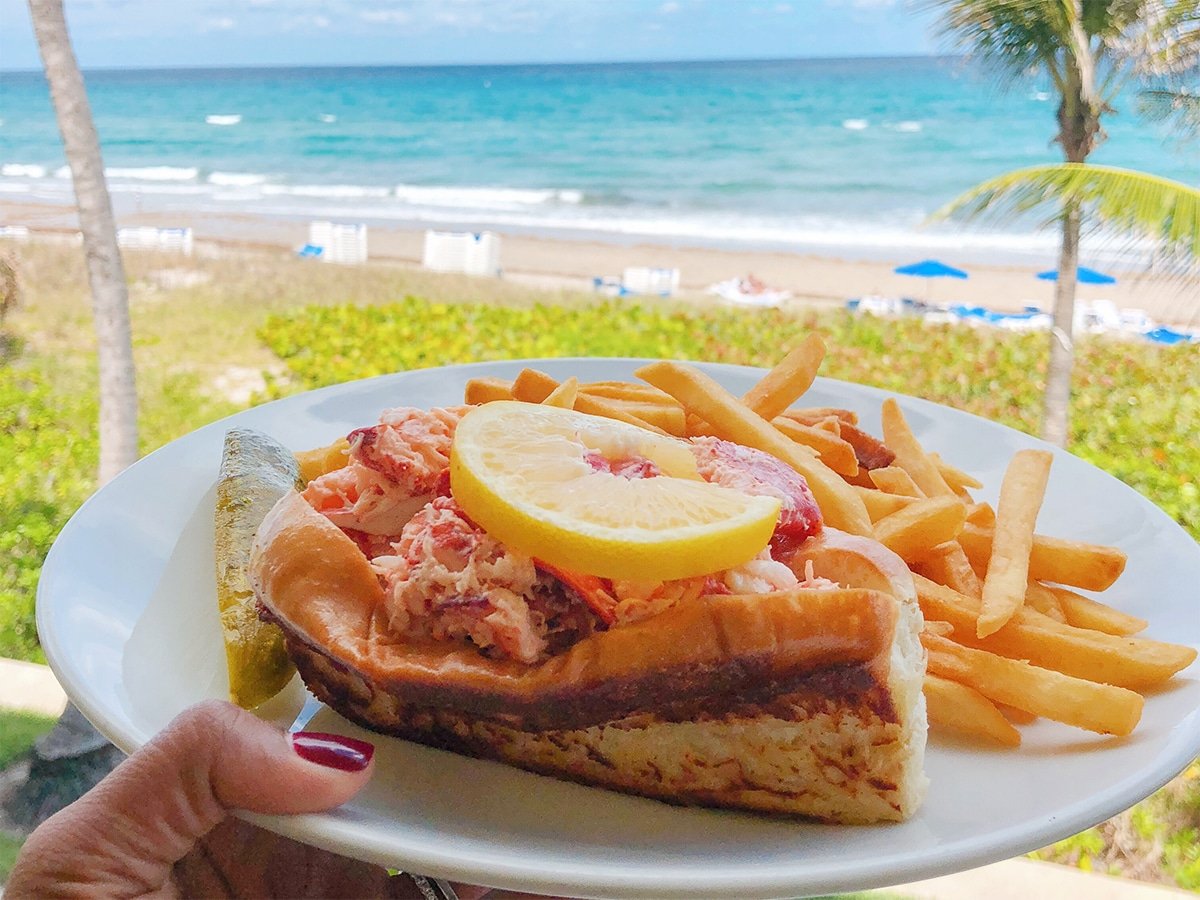
When my bowl of ramen finally arrived at Hidakaya, a small affordable restaurant in the busy Akihabara section of Tokyo, I pondered the journey it took me to get here. Flashback to my first memory as a conscious person in my parents’ kitchen. My mother brings me a bowl of steaming noodles with butter and salt. When I got my first cat, I named him “Noodles.” I used to sneak him elbow macaronis under the table at dinner. Of all the fantastic meals I have had all over the the world, this is the one I have been waiting for.
The classic shoyu ramen before me (590 yen/$5 USD with six gyoza potstickers) is a deceptively simple dish. Just noodles in broth with a few slices of pork (chashu), pickled bamboo shoots (menma), a small sheet of nori (seaweed), and sliced green onions.
The shoyu (soy sauce) broth has been cooked for hours with chicken and vegetables. It is incredibly flavorful with a thin layer of fat on the top. The long wheat noodles are fresh, curly and satisfying with just a hint of resistance to the bite. The stewed pork (cashu) slices are tender and rich. Green onions add color and freshness to compliment the deep broth. Pickled bamboo shoots add a tangy acid to balance to the fat and the nori offers a hint of ocean flavor saltiness.
The restaurant is relatively void of loud conversation; the food is so good it demands concentration. Only the sound of intense slurping is heard. My life’s journey is rewarded with the best bowl of noodles I have ever had.
My recent trip to the Kantō region of central Japan brought me to the Tokyo metropolis and the bordering prefectures (states) of Saitama and Chiba. Here are some highlights of what to see, do and eat, and a few overlooked destinations close to Tokyo that many travelers pass by without knowing how close they were. First up:

Tokyo
Tokyo is a planet unto itself, a thriving, glowing mass of 13 million people. It is nothing less than spectacular and must be experienced and tasted. It is a mix of neon-future-electronic-gadget heaven and ancient tradition. It is bursting at the seams and has some of the best food in the world. See/eat at:
- Tsukiji Fish Market — This is not optional. You must go here. The largest fish market in the world, it is surrounded by a maze of outer markets and winding streets lined with stalls and packed with people. Everything that has anything to do with fish can be found here. Fresh, raw tuna is everywhere. The food stalls and sushi counters are incredible. Remember, Japan is one of the safest countries on the planet. Just wander, get lost in the crowd and eat as much as you can.

Tokyo harbor from the cruise - Amitatsu dinner boat cruise — Cruising on the Sumida River in Tokyo bay on a small traditional yakatabune (houseboat) while eating dinner and drinking endless sake is as good as it sounds. A 2.5 hour trip for about $90 USD. Just the chance to see Tokyo rising from the waters of the harbor would have been enough, but the food was fantastic.

Amitatsu dinner boat cruise food Shrimp tempura, sushi, sashimi, shellfish soup, rice, marinated whitefish a savory custard, and as much beer wine and sake as you can consume. Yes, we were the only Americans on the boat, but good food and sake are potent translators and the Japanese are incredibly friendly. By the end of the cruise it felt like family as we all applauded when the candles were blown out on the cake for an 80th birthday party.

Narita, Chiba prefecture (guide)
Narita airport is the main international hub for the Tokyo area. It is about 37 miles from downtown Tokyo station. Most travelers either move on to the city, or wait in the airport to connect with other flights. But the airplane crews that pass through or spend the night flock to Narita city to eat and drink. See/eat:
- Naritasan Shinshoji — Only 10 minutes by train from the airport, the temple is also home to the 1000-year-old Naritasan Shinshoji Buddhist temple, a pilgrimage for many Japanese. Free guides are available to explain the history and philosophy of the temple and walk you through the many ancient temples and gardens. It is a beautiful and calm place. Under the guidance of one of the temple’s monks, Harada, I participated in “shakyo.” This is the copying of sutras, the words of Buddha, in pen and ink. A serene meditation that slowed me down from my frantic pace and apparently put me on the right side of Buddha.

Naritasan Shinshoji Buddhist monk, Harada - Omotesando Street — Leading to the entrance to the temple, the street is lined with shops offering local specialties like sake, azuki bean jelly (yokan), and bright crisp cucumber pickles on a stick (tsukemono) for 100 yen. ($0.85 USD).

Unagi at Surugaya in Narita - Unagi — Inevitably as you walk along Omotesando Street, you will be drawn in by the enticing aroma of smoky grills dripping with sweet sake, shoyu and the local specialty, unagi (eels). I visited the two main unagi restaurants, Kawatoyo and Surugaya, both with wide-open kitchens and grills right on the street. Chefs deftly dispatch live eels, securing their heads with a spike they are skinned and skewered. At Surugaya, they use Choso Choso charcoal only. It burns extraordinarily hot and clean. Their tradition of cooking goes back hundreds of years. Fresh eels are cooked three times.
-

Kawatoyo restaurant in Narita grilling eels First is a base grilling with no seasoning. Then the eels are steamed, dipped in a sauce of local Shimosa shoyo, premium local sake, mirin and sugar, and finally grilled again to a delicious crisp dark glossy finish. Neatly arranged on rice and served with a simple dashi mushroom soup, pickled carrot and daikon radish, this incredible dish is as much of a pilgrimage for the Japanese as the temple. During the first days of the new year, 4-5 hour lines are normal. Eel stocks are on the decline in Japan and they do not come cheap. This will set you back about 3200 yen/$28 USD, but the total immersion into Japanese food culture capturing all of your senses is worth every penny.

Saitama prefecture
In Saitama, you can—and must—live like a sumo wrestler at Miyamoto House. Kazuteru Miyamoto is a gentle giant of a man. His smile and good nature mask the force within that was unleashed during his illustrious career as a sumo wrestler he retired from four years ago. He is the 12th-generation owner of this 200-year-old renovated traditional Japanese house.
We sit in kura, the bar that was originally the store room for the home. The room is adorned with samurai swords and weapons. It is the ultimate sumo man cave, well-stocked with an extensive collection of sake and over 50 kinds of homemade “mountain fruit” liquors. Yes, there was a snake in a bottle and it was strong as hell and delightfully horrible. I loved it.

Above the bar is an exhibition room of memorabilia from Kazuteru’s wrestling days. Sumo wrestlers are warriors who live to gain the strength and weight needed to clash with giants. The “moment of force” between them is intense often resulting in injuries to the back and knees.
He told me of his training routine. From 5 am to 10 am, he would exercise and have practice bouts. Then a huge lunch of hearty chanko nabe stew, the classic sumo meal. Followed by a nap, said to help gain weight. In the afternoon he would strength train for two hours. For dinner, another giant serving of chanko nabe stew. This evening’s dinner would include, you guessed it: chanko nabe stew.
The main part of the house has six suites that center around an interior cooking and dining area. The rooms each have a private hot spring tub and access to a communal pool. They are covered in tatami floor mats, in the classic (Ma) minimalist style. In Ma philosophy, less is more, it is the space between; there is no clutter. It was calming to my soul and elicited a personal promise to clean out my junk drawer of a life back at home.

Dinner was truly special and extensive. Most ingredients are farm-to-table grown on the family farm. Locally caught whitefish were grilled on skewers over charcoal. Cold potato soup, sashimi, snails, rice with three types of mushrooms, tempura, pork belly, oysters, and steamed eggs in dashi broth with pork and shrimp.
The final piece was the chanko nabe stew, finished at the table. Made with dashi (seafood stock), mirin, shoyu, sake, pork, fish, mushrooms, cabbage, carrots, green onions, chicken meatballs, ginger sesame oil, miso, daikon radish, fish, tofu, and whatever else is fresh and available. It is a hearty, healthy and soothing concoction often eaten with rice or udon noodles and vast amounts of beer.
My final meal in Japan was at the Tokyo airport before my flight back to to Boston, MA. If you have a six hour layover or more, the airport offers free guides and a series of reasonably priced local mini tours via the Narita Transit program. They guarantee you will arrive back in time for your next flight. I only had an hour to spare and knew exactly how I would end my trip.

At the airport
I sat down to a bowl of tonkotsu ramen at Menya Kookai Noodle Shop in terminal 2 on the 4th floor. A rich pork bone broth, chashu pork, egg, menma bamboo, shoots, and thick curly noodles. Not too shabby for airport food—and $7 USD. I swore I could hear my dearly departed cat “Noodles” purring in Hello Kitty heaven.

How to get there: with JAL
I flew from Boston, MA to Tokyo on Japan Airlines flight #7 (a Boeing 787-9). The food was great, and the staff were fantastic. There is a good selection of current movies and free drinks. Try the Hakutsru sake.
It’s a long flight of over 13 hours and if you’re flying economy, you’ll want a good seat. I highly recommend 45A. It’s an exit row at the start of the rear cabin with plenty of legroom and no one to climb over to get to the bathroom, and you get fed first.
Where to stay
- Urawa Royal Pines Hotel (Saitama) — A mid-sized hotel with a killer breakfast buffet. Try the fresh udon noodles and broth.
Address: 2-5-1 Naka-cho, Urawa-ku, Saitama-shi, Saitama 330-0062
Telephone: +81 48-827-1111 - Hilton Narita (Narita) — This is where many airline crews stay at the airport. Great place and easy to get to and from if you have a layover.
Address: 456 Kosuge Narita, Chiba 286-0127
Telephone: +81 476-33-1121 - Miyamoto-ke (Saitama) — A traditional Japanese farmhouse owned by a retired sumo wrestler. Hot tubs in each room and superb food about 1.5 hours from Tokyo by train.
Address: 510 Oganonagai, Chichibu-gun, Saitama 368-0102
Telephone: +81 494-75-4060 - Shinagawa Prince Hotel (Shinagawa)
Address: 0-30 Takanawa 4-chome, Minato-ku Tokyo, 108-8611
Telephone: +81 (0)3-3440-1111

Translator services
In Japan you will find many people speak English, but most do not. The language barrier is intense. With no linguistic common ground, at times I found myself dead in the water except for my kabuki-like pantomimes which occasionally elicited directions to a bathroom. Many signs are in English but you may need some help.
Kazuo Tashiro is the real deal. He’s more than just an interpreter; his knowledge of Japanese history, politics, food, and culture is impressive. Here’s how to get in touch:
- Email: merseyjp7@ymobile.ne.jp
- Telephone: +81 90 6491 0223
All photos credited to Paul Shoul.









Some epic looking eats. I miss Japan